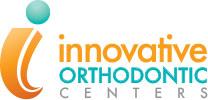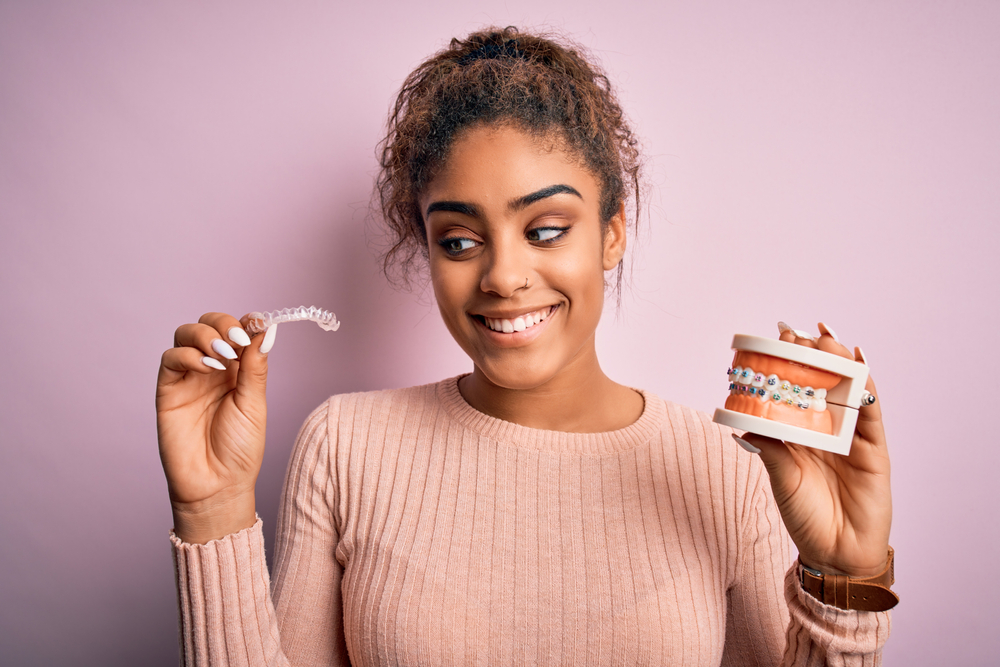Types Of Orthodontic Treatments:
Years ago, if you wanted to straighten your teeth, metal braces were really the only option. Thanks to innovations in engineering and materials, that’s not the case anymore. Today, there are different types of orthodontic treatments to truly suit any smile.
At Innovative Orthodontic Centers, we’re leaders in comfortable, accelerated orthodontics and we rely on cutting-edge technology and treatments to help our patients get amazing smiles more efficiently and comfortably. We’re covering the different types of orthodontic treatments we offer at our practice to help you get an idea of which one might be best suited to your lifestyle and smile needs.
SURESMILE®
Before we get into the different types of braces, we have to discuss SureSmile since Dr. Manal Ibrahim and Dr. Christine Gin use the SureSmile prescription wire system with all of the braces at our practice. The system relies on precise, computerized treatment planning that allows the doctor to design your smile by manipulating a 3D model of your teeth with special software tools. A custom archwire is created just for you based on our doctors’ specifications, using robotic wire-bending technology.
This means a much more comfortable braces experience. Additionally, since the teeth are taking a more direct path to their ideal positions and the treatment planning is more accurate, treatment times are on average 29% faster. This is because we avoid creating unwanted movements and go directly to the desired final result. Because we are one of the top Suresmile providers in the world, we have the experience and knowledge to achieve exceptional braces results with this system.
SELF-LIGATING METAL BRACES
Metal braces are the most common type of braces and what a lot of people think of when they hear the word “braces.” They’re bonded to the teeth and have a track where the archwire is placed in order to guide the teeth into place.
There are two types of braces on the market today: traditional braces and self-ligating braces. Traditional braces have been around for a very long time and need tiny elastics or metal ties, known as ligatures, to secure the wires to the brackets. The ties cause friction, which slows down tooth movement and can lead to extended treatment times. In addition, the ties trap plaque and food debris extending oral hygiene routines for the patient. This type of braces limits how much movement the teeth can express and may require extraction of permanent teeth to get proper alignment.
Luckily, at our practice, we use In-Ovation® self-ligating braces. These braces don’t use ligatures. Instead, they utilize free-sliding technology, which allows for a more comfortable treatment since there is no need for tightening. Also, no ligatures means better oral hygiene throughout treatment. In many instances, due to their mechanics and precision, these braces allow for treatment without extraction of permanent teeth. Whether you want braces for gaps between your teeth, to fix a crossbite, or anything in between, our team can get you there!
ARE METAL BRACES RIGHT FOR ME?
Metal braces are great for patients who want to show off the shimmer of their hardware. Our self-ligating metal braces are much smaller, more streamlined and way more attractive than traditional ones. Braces are bonded to the teeth and the doctors at our practice create the plan for an incredible result.
A benefit of braces vs. Invisalign for some people is that since the brackets are bonded to your teeth and stay in place throughout your treatment, you don’t have to think about them or worry about losing them like you do with aligners. All you have to do is come to your scheduled appointments, wear rubber bands as instructed, keep excellent hygiene, and avoid certain foods to eliminate breakage of your braces and you will finish your treatment on time. While these metal braces are lower profile, they’re still visible. If you don’t like the idea of drawing attention to your smile, they may not be the best choice for you.
SELF-LIGATING CLEAR BRACES
Dr. Ibrahim and Dr. Gin also offer In-Ovation® ceramic braces. These braces are self-ligating as well and rely on the same system of brackets and wires as their metal counterparts. However, they’re made from a translucent material and blend in with your smile. Our Shorewood and Naperville clear braces patients love that they’re much less noticeable than metal braces. Unlike older versions, these clear braces are very strong and durable and they won’t stain.
ARE CLEAR BRACES RIGHT FOR ME?
Clear ceramic braces are a great alternative to metal braces for those who want an aesthetic option. They are the most popular types of braces for adults and older teens. They’re also bonded to the teeth so you don’t have to keep track of them or worry about wearing them for a prescribed amount of time. Once they’re in place, they’ll stay there until you finish treatment. As with any type of braces, you will have to boost your oral hygiene efforts and brush and floss around brackets and wires. Additionally, while clear braces are less visible than metal braces, they’re more noticeable than Invisalign.
INVISALIGN®
Though braces are an amazing treatment option, especially considering we use the innovative SureSmile® system, if you’d rather straighten your teeth without braces, Innovative Orthodontic Centers is an Invisalign Diamond+ Top 1% Provider. This means we’re not just a top Shorewood and Naperville Invisalign provider; we’re actually among the top Invisalign providers in the world. Dr. Ibrahim has even been called a “trailblazer” by Align Technology, the company that makes Invisalign. So, when it comes to experience, we have it in spades!
Invisalign involves a series of clear, removable, BPA-free plastic aligners. Our doctors map out your tooth movements on a computerized, 3D model of your teeth and customize a unique plan for you. Once they complete your comprehensive work up, they order your custom aligners based on your prescription. You wear each set of aligners for about 22 hours per day, changing them every week or so. As you make your way through the series, your new smile gradually takes shape.
If you want to reduce your treatment time by up to 50%, you can combine Invisalign with AcceleDent® or VPro+™. We’re the number one AcceleDent provider in the world and a leading VPro+ provider. By pairing one of the handheld, take-home devices with your Invisalign, you can speed up tooth movements and get more predictable results.
Now, what about Invisalign for kids or teens? We’ve got you covered there too with Invisalign First, Invisalign Teen and Invisalign with Mandibular Advancement (MA). Invisalign First is made for growing smiles and is used for early interceptive treatment on patients who have a mixture of baby teeth and permanent teeth. Invisalign Teen is designed for a teenager’s needs and has features like eruption tabs for erupting molars and compliance indicators. Invisalign with MA combines clear aligners with features that advance the lower jaw to help correct an overbite without using a headgear or other invasive appliances!
IS INVISALIGN RIGHT FOR ME?
Invisalign is the least noticeable of all of our orthodontic treatments and most people won’t be able to tell you’re wearing the aligners, which is a huge benefit for some of our patients. It’s also comfortable and since the aligners are removable, there are no food restrictions and you can brush and floss as you normally would. If you already struggle with keeping up with your oral hygiene routine, Invisalign is a great option. While for many people, the fact that Invisalign is removable falls in the pro column, for those who have a hard time keeping track of things, the removability can be a negative.
ALL ABOUT RETAINERS
No matter which of the above treatment options you choose, you’ll need to wear a dental retainer to prevent your teeth from shifting after braces or Invisalign. When you finish your orthodontic treatment, we’ll design a custom, clear Vivera® retainer, sometimes referred to as an Invisalign retainer since it’s made by the makers or Invisalign, for you.
We’ll take a digital scan of your mouth and 3D CAD CAM technology will be used to create four sets of retainers so you always have backups. We’ll even store the 3D model of your mouth in our cloud for 10 years, ensuring a replacement is a phone call away. By wearing your retainer according to our instructions, your smile can last a lifetime.
What Causes Teeth Shifting After Braces or Invisalign?
Your braces or Invisalign aligners exert steady, gentle pressure that stimulates the natural process of bone remodeling. This is where the bone and tissues break down, allowing the teeth to move where we want them. Once the pressure from your appliance is removed, if you don’t wear a retainer, then you’ll experience teeth shifting after braces or clear aligners.
Why? Well, it takes time for the bone and tissues to reform around the teeth and the ligaments to tighten back up, locking your pearly whites in place. If your teeth aren’t held in position with a retainer as this occurs, they’ll naturally move back towards their old places. Additionally, as you age, the teeth also move a bit, which can result in shifting if a retainer isn’t worn.
Will Wearing Old Retainers After Teeth Shift Work?
If you were diligent about wearing your retainer and your teeth move a tiny bit, then, yes, wearing old retainers after the teeth shift could be effective. As long as your retainer fits and you don’t have to force it in, your retainer can help you reclaim your smile because it’s molded based on your final braces or Invisalign results. Therefore, it will guide teeth back in that position.
Wearing old retainers after teeth shift won’t work, however, if you’ve experienced anything more than very minor movement. This is particularly true if the retainer is hard to get in or doesn’t fit. If you have to force it, then wearing an old retainer to shift the teeth back can damage them at worst. At best, it won’t do anything, because retainers aren’t designed to achieve serious tooth movements.
If your old retainer doesn’t fit, we can sometimes take new scans and create a new retainer for you to prevent further teeth shifting after braces or Invisalign. It’s important to note that this will hold your teeth where they currently are and won’t move them back to the positions they were in when your braces were removed or you finished Invisalign. If you want your teeth to return to their post-treatment positions, you may need to get braces or Invisalign again.
The good news is, if you need a touch-up, we do offer limited Invisalign treatment with Sensational Smiles. This orthodontist-directed, at-home option works in half the time and for 60% less than the cost of comprehensive orthodontic treatments, making it ideal for people who had a relapse after their initial orthodontic treatment. It’s safer and more effective than wearing old retainers after the teeth shift. Plus, you’ll get the convenience of at-home treatment without cutting corners.
Schedule Your Complimentary Consultation Today!
At your complimentary consultation, we’ll help you decide on the best option for you between all types of orthodontic treatments we offer. Whether you go for one of the types of braces or you’d prefer Invisalign, we’ll create a custom treatment plan and ensure you get amazing results efficiently and comfortably. To get started on your new smile book a virtual consultation today!





